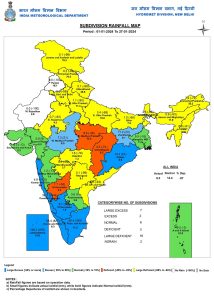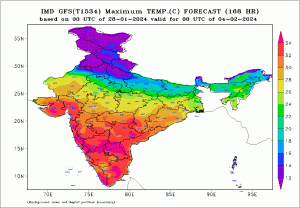The long wait for fresh snowfall over the western Himalayas has come to an end as a feeble western disturbance on Republic Day brought light snowfall over various high reaches of Kashmir, Ladakh, and Himachal Pradesh on January 26 and 27. It was one of the longest waits for snow, as both December and January were bone-dry and warm in the hilly states. In January 2024, Jammu and Kashmir and Ladakh subdivisions received 0.1mm of rainfall against the normal of 79.3 mm; the departure from normal stands at a whopping -99 per cent. Himachal Pradesh and Uttarakhand have received mere 0.2 and 0.1 mm, and their departure from normal too stands at -99 per cent for the first 27 days of the month. Not just the Himalayas but the northern plains have seen dry weather conditions for the entire January. The departure from the normal conditions in Punjab, Haryana Chandigarh, Delhi, east UttarPradesh, west UttarPradesh, west Rajasthan, east Rajasthan stands at -100 per cent, -99 per cent, -68 per cent, -90 per cent, -100 per cent and -83 per cent respectively. The absence of active western disturbance resulted in such massive dry chaos in India. The Republic Day western disturbance has also brought relief from severe cold day conditions in the plains of north India. Wind speed has increased starting on January 25, paving the way for early lifting of surface fog, and sunny days got a chance to show up properly on January 26 and 27 after almost a month as foggy days were exceptionally high this time. As fog lifted up nearly after 30 days, the maximum temperature has crossed the 20°C mark to a large extent. Reported maximum temperature on January 27, 2024: Amritsar: 21.8°C Ludhiana: 21.8°C Patiala: 22.0°C Chandigarh: 21.4°C Hisar: 21.4°C Rohtak: 20.1°C New Delhi: 24.0°C Meerut: 22.0°C Kanpur: 20.6°C Lucknow: 20.5°C Varanasi: 23.0°C Prayagraj: 23.6°C Despite the rise in daytime temperatures, they are still prevailing close to the normal temperature range; however, this brought a major respite from cold and muggy conditions as temperatures hardly crossed the 15°C mark from a couple of weeks ago. [caption id=“attachment_13664932” align=“alignnone” width=“300”] (Despite the rise in temperature, north India will end January on a historical note in terms of maximum temperature anomalies.)[/caption] Winters have tightened grip in the interiors of the country for a brief period in the past week, when Pune recorded the coldest morning of the season with a minimum temperature of 8.6 °C on January 25. This is the lowest minimum temperature recorded there after February 15, 2023. Maximum and minimum temperatures recorded on Republic Day in Mumbai and nearby Konkan region: Mumbai: 33.0°C /16.3°C Virar 34.0°C/14.0°C Navi Mumbai 34.0°C/15.0°C Panvel: 34.4°C/14.0°C Badlapur: 34.4°C/11.4°C Talasari: 35.0°C/10.6°C Kalyan: 35.0°C/13.6°C Karjat: 35.0°C/12.4°C Thane: 35.0°C/14.8°C Ratnagiri: 35.4°C/18.8°C Savarde: 36.0°C/12.2°C Dapoli: 36.0°C/14.0°C Chiplun: 36.8°C/15.0°C It has been a very short winter for south India this year. From February onwards, generally, summer starts onset in parts of Kerala, but this time it has started in January itself as the maximum temperature has been seen crossing the 35°C mark at a few stations: Maximum temperature reported in parts of Kerala on January 27, 2024: Kottayam: 35.6°C Kannur: 35.6°C Punalur: 35.4°C Kozhikode: 34.9°C Kochi: 34.7°C Alappuzha: 34.4°C Trivandrum: 33.4°C The pan-India actual rainfall so far in the period of January 1 to 27 stands at 6.2 mm against the normal of 14.4 mm; the departure from normal currently stands at -57 per cent, increasing by 3 per cent week over week. Subdivision-wise winter seasonal rainfall till January 27, 2024: • Southern peninsula: Actual 17.3 mm against the average of 7.1 mm, +144 per cent departure from normal. • East and northeast India: Actual 4.8 mm against the average of 14.0 mm, -66 per cent departure from normal. • Northwest India: Actual 0.7 mm against the average of 28.3 mm, -97 per cent departure from normal. • Central India: Actual 5.3 mm against the average of 6.1 mm, -14 per cent departure from normal. [caption id=“attachment_13664952” align=“alignnone” width=“214”]
 Subdivision-wise winter seasonal rainfall in India from January 1 to 27, 2024[/caption] Current synoptic weather features influencing weather in India as on January 28, 2024:
Subdivision-wise winter seasonal rainfall in India from January 1 to 27, 2024[/caption] Current synoptic weather features influencing weather in India as on January 28, 2024:
- A fresh western disturbance seen as a trough in middle tropospheric westerlies at 5.8 km above mean sea level runs roughly along Long. 50°E to the north of Lat. 30°N.
- Another western disturbance is likely to affect the western Himalayan region and adjoining plains of northwest India from January 31, 2024 onwards.
- No other synoptic weather feature is active in any part of the country.
[caption id=“attachment_13664972” align=“alignnone” width=“270”] Satellite imagery on the evening of January 28 shows western disturbances affecting the Himalayas and overcast conditions in the plains of north India[/caption] All India weather forecast till February 4, 2024: The sunshine in the plains of north India over the weekend would not last longer as back-to-back active western disturbances are expected to drench north India in the upcoming week. Currently, a moderate-intensity western disturbance has started influencing Kashmir and Ladakh on January 28, and cloudy weather is experienced in Punjab, Haryana, Delhi NCR, Rajasthan, and Uttar Pradesh. The rise in temperature that was observed on Saturday has again diluted as temperatures dropped on Sunday. Now an active western disturbance is likely to impact the entire north India from January 31 to the first half of February 2. This system will result in widespread heavy snowfall over Kashmir, Ladakh, Himachal Pradesh, Uttarakhand, and Sikkim. Major hill stations like Srinagar, Shimla, Manali, Dalhousie, Dhanaulti, Mussoorie, and Nainital will experience the season’s first blanket of snowfall during this spell. The season’s first winter rain is also predicted to occur in Punjab, Chandigarh, Haryana, Delhi NCR, and Uttar Pradesh from January 31 to the night of February 1; however, the intensity is expected to be light to moderate, and spread-wise, it should be scattered in nature. A couple of rain clouds can possibly develop convectiveness, and thundershowers and hailstorms might occur in isolated places. A brief break is expected on February 2 and 3, followed by a stronger western disturbance that is expected to impact north India from February 4 to 6. This will bring another great spell of snowfall and rain to the parched hills and plains of north India. The much-awaited wet weather is all set to kick in. Cloudy weather will result in a rise in minimum temperature by 3 to 5°C across the next week, but maximum temperature will be recorded in the cold day range, especially on rainy days. Hence, the current relief from severe cold is temporary as next week the weather conditions will be wet and cold across north India. [caption id=“attachment_13664982” align=“alignnone” width=“300”]
 Predictions for the first week of February indicate cold day conditions in the plains of north India and the Himalayas, while rising daytime temperatures in the rest of India.[/caption] Except in north India, it is likely to be a silent week for most parts of India. However, whenever a western disturbance influences the northern parts, it sends down cool northwest winds towards the interiors of the country. Hence, a dip in night temperature is expected by 2-3°C from current levels across Madhya Pradesh, Chhattisgarh, Odisha, Jharkhand, Gujarat, Maharashtra, Andhra Pradesh, Telangana, and Karnataka from February 1 to 4. While nights are likely to be cooler, days will be exactly opposite as the air blowing from land heats up quickly. We can expect high diurnal variations in temperature across the peninsula, as the minimum temperature is expected to be around 10°C in central India and around 15-20°C in the peninsula. But day temperatures are likely to cross the 35°C mark at a lot of stations in the central and southern parts of the country starting from January 30 onwards, leading to warmer conditions during the day. The writer, better known as the Rohtak Weatherman, interprets and explains complex weather patterns. His impact-based forecasts @navdeepdahiya55 are very popular in north India. Views expressed in the above piece are personal and solely those of the author. They do not necessarily reflect Firstpost_’s views._ Read all the
Latest News ,
Trending News ,
Cricket News ,
Bollywood News , India News and
Entertainment News here. Follow us on
Facebook,
Twitter and
Instagram.
Predictions for the first week of February indicate cold day conditions in the plains of north India and the Himalayas, while rising daytime temperatures in the rest of India.[/caption] Except in north India, it is likely to be a silent week for most parts of India. However, whenever a western disturbance influences the northern parts, it sends down cool northwest winds towards the interiors of the country. Hence, a dip in night temperature is expected by 2-3°C from current levels across Madhya Pradesh, Chhattisgarh, Odisha, Jharkhand, Gujarat, Maharashtra, Andhra Pradesh, Telangana, and Karnataka from February 1 to 4. While nights are likely to be cooler, days will be exactly opposite as the air blowing from land heats up quickly. We can expect high diurnal variations in temperature across the peninsula, as the minimum temperature is expected to be around 10°C in central India and around 15-20°C in the peninsula. But day temperatures are likely to cross the 35°C mark at a lot of stations in the central and southern parts of the country starting from January 30 onwards, leading to warmer conditions during the day. The writer, better known as the Rohtak Weatherman, interprets and explains complex weather patterns. His impact-based forecasts @navdeepdahiya55 are very popular in north India. Views expressed in the above piece are personal and solely those of the author. They do not necessarily reflect Firstpost_’s views._ Read all the
Latest News ,
Trending News ,
Cricket News ,
Bollywood News , India News and
Entertainment News here. Follow us on
Facebook,
Twitter and
Instagram.


)

)
)
)
)
)
)
)
)



